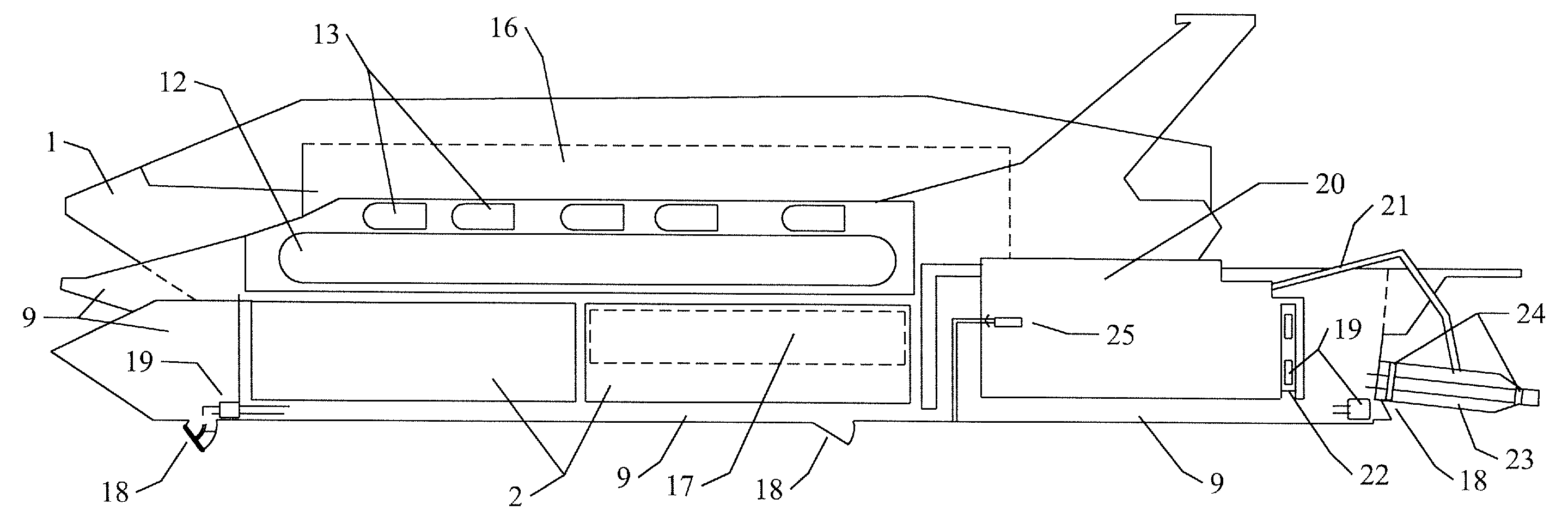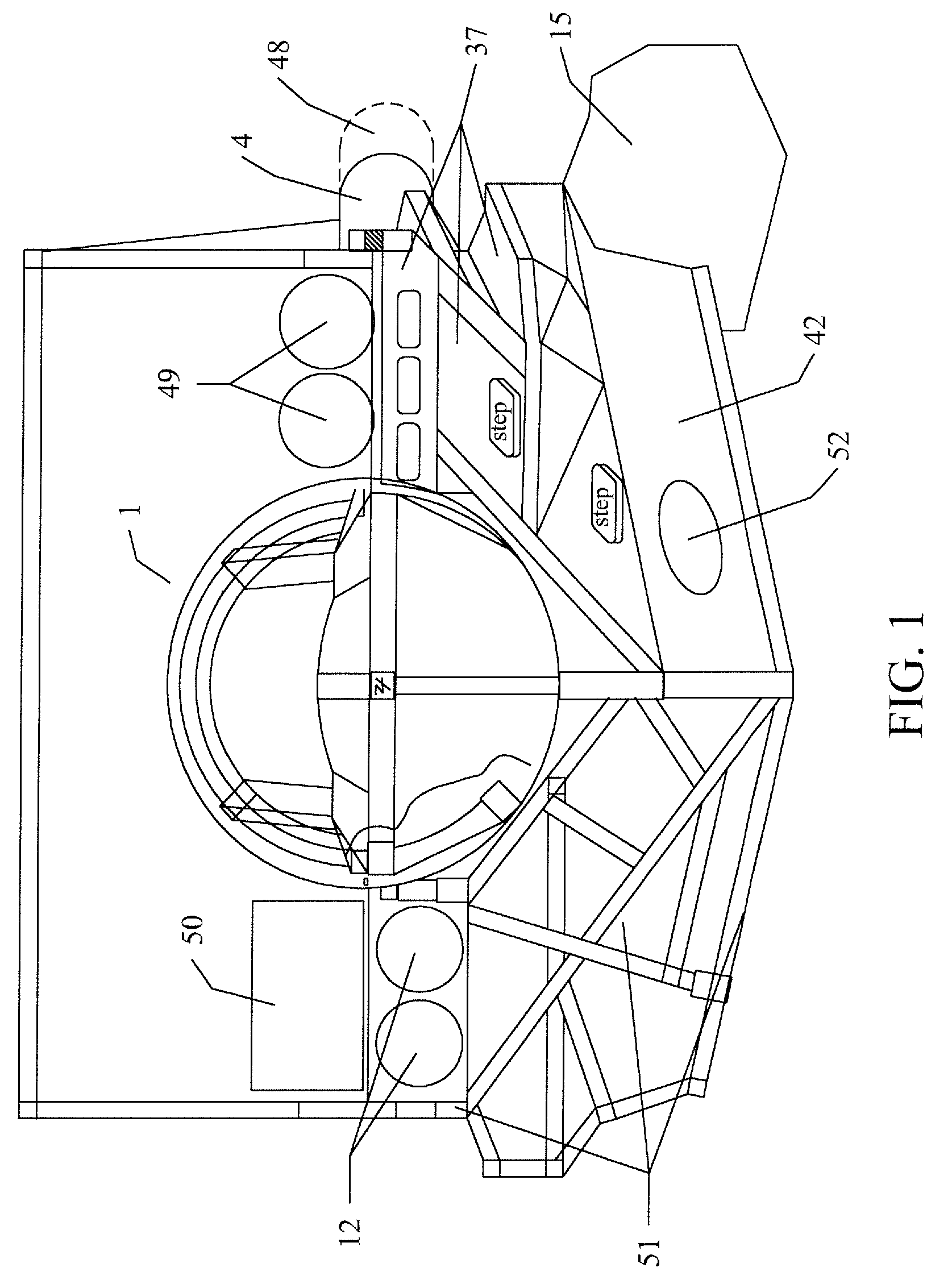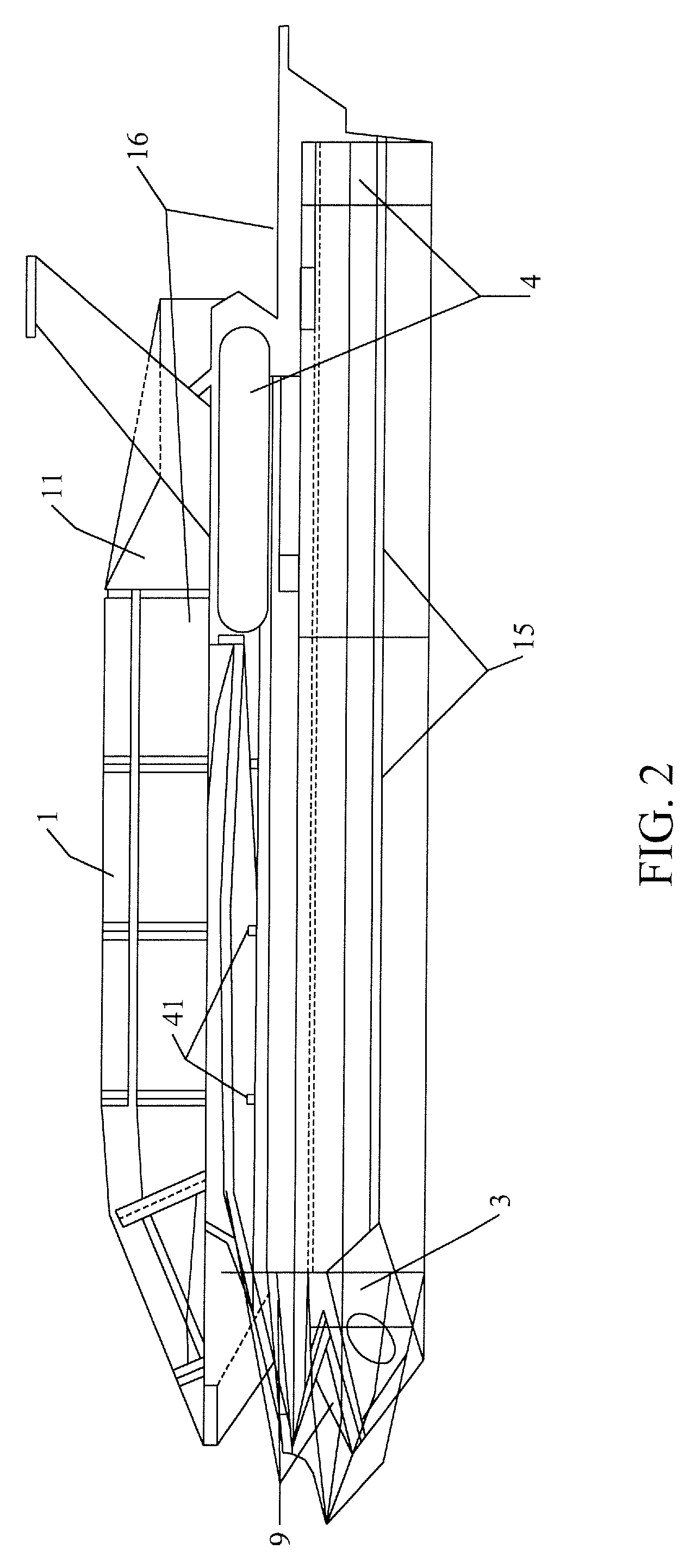A submersible is generally considered any vessel that can submerge and operate
underwater, but may have limited or no capacity to navigate the seas on its own.
Due to this fact, these small submersibles are not able to rise high enough above the surface to allow a majority of their volume to reside above the
waterline.
They are not able to achieve the amount of positive
buoyancy necessary to do so.
However, this design approach gives very limited ability to travel on the surface and allows a very low degree of variability in
payload.
Despite a large quantity of submarines and submersibles for many specialized tasks, no true general-purpose vessel capable of
underwater operation exists that can be used for
multiple applications.
There is also currently no underwater vessel that is small, cost-efficient, and possesses significant autonomy, navigation capacity, and range.
Nevertheless, all existing submarines and submersibles share the common trait that they are each designed for a very specific purpose and have limited utility in applications outside of their intended use.
They are far too expensive and impractical to transport cargo.
Industrial use is not practical for these submarines since their size prevents operation around or under other vessels or offshore platforms.
The lack of windows, large
crew size needed for operation, and huge cost to produce precludes any tourism or
recreational use.
Thus, these huge military submarines have no other use besides their current warfare platform.
There are many existing submersibles collectively capable of a variety of different uses, but each individually only useful for a specific task.
The main limitation of any
ambient pressure submersible, including a diving bell, is a result of the limitations of the human passengers.
If too much
nitrogen enters the blood, narcosis may result.
This is a slow process; the longer time spent at depth, and the deeper the depth, the longer the expulsion of excess gases takes.
If the
ambient pressure submersible rises too quickly, the gases in the blood can bubble and cause “the bends,” which is very painful and can result in a fatal
embolism.
This limits the usefulness of
ambient pressure submersibles to the same depths that SCUBA divers can reach.
The pressure from the water tends to crush the passenger compartment more and more as the depth increases, though.
Any deviation from these shapes greatly reduces the pressure tolerance and thus the
maximum depth reachable by the
hull.
These precise tolerances increase the time and expense of constructing the
hull.
Diving bells and bathyspheres are both limited by the heavy steel cable connecting them to the surface or a surface vessel and by their complete lack of autonomy, both on and below the surface.
The lack of self-propulsion,
power storage, and
buoyancy control, along with the hindrance of the large cable, prevent either of these from being submersible vehicles.
The bathysphere is limited to a depth of about 3,500 feet while diving bells become dangerous deeper than around 300 feet.
DSVs usually require a support vessel and cannot navigate.
The
pellets are held in place in hoppers via electromagnets, meaning that
electrical failure would result in the vessel immediately rising towards the surface.
Battery-powered electric thrusters provide propulsion and steering under water, but this capability is extremely limited due to the large
superstructure.
While being able to dive to great depths, the bathyscaphe is very limited by its size and low maneuverability under water.
It is also difficult to launch and recover.
These vessels are typically negatively buoyant when diving, using the force of gravity to sink until the desired depth is reached.
The reliance on
drop weight to return to the surface can be a problem for deep-dive submersibles.
If reconfiguration is desired or if a weight needs to be lifted during a dive, this can be difficult to achieve.
Since the
pressure hull's displacement is needed to rise to the surface, any flooding of the
pressure hull will cause the vessel to sink to the bottom.
The precise
engineering necessary to help avoid this risk increases the cost of production.
Additionally, DSVs have very small passenger compartments.
The U.S. Navy has one DSV that is larger than most typical DSVs, but it is too expensive to be practical for non-military purposes.
Overall, DSVs are useful for a very
small range of tasks but are severely limited by their lack of range,
seakeeping ability, autonomy, and speed.
Tourist submersibles are not useful for purposes other than sightseeing.
They lack speed, autonomy, and navigation capability.
Tourist submersibles must be large in size to be cost effective, but their size causes them to be depth-limited due to the large force exerted on the
pressure hull.
Thus, any failure of a pressure
hull penetration could cause the submersible to sink to the bottom.
However, these vessels still lack open-ocean navigation ability and are very limited in their range.
They are also unsafe to operate in even moderately rough seas and still suffer from the problems of other tourist submersibles with respect to depth, speed, size, and cost.
This limits their use to depths that a SCUBA diver can reach.
Wet hull submersibles are obviously very limited in their use.
The passengers are exposed to the
water temperature, which can be problematic in cold climates.
The passengers are also exposed to pressure at depth, which means wet hull submersibles are limited to depths of around 200 feet even when manned by expert divers using
mixed gas for
breathing.
The passenger compartment is completely enclosed, but still flooded.
More importantly, though, they are limited by the
human body.
They have little surface range, seafaring capability, or autonomy.
A few ambient pressure personal submersibles have been built with diesel surface engines, but they still face the same depth limitations as all other ambient pressure designs.
It uses only battery power for propulsion, which severely limits its range and seafaring abilities.
The cost of these submersibles is extremely high, meaning they have no non-military use.
It has historically proven difficult to design a relatively small submarine capable of long-range navigating and seakeeping at high speed.
Typical submarines that do the listed capabilities are extremely large, bulky, and expensive.
Private industry has solved the navigation issue by transporting small submersibles using surface vessels, which is costly and wasteful.
However, the desire for long-range navigating and seakeeping at high speed indicate that such a
general purpose vessel should be a true submarine, not a simple submersible, thereby making it more difficult to design.
Long-range
underwater navigation has only been successfully accomplished through the use of
nuclear power or enormous battery banks charged on the surface by diesel power.
These methods are practical in large, transoceanic military submarines, but are not possible in a smaller submarine.
Existing designs of small submersibles are incapable of acting as a true
surface craft.
Batteries are very limited in the amount of energy they store, so to operate as a true
surface craft, a vessel should carry a large, heavy fuel load.
However, it is not a simple task to add such engines to an existing submersible design.
Attempts that have been made to add diesel engines to tourist submersibles or smaller industrial submersibles have been ineffective since their functionality is limited by the design of the submersibles.
The first reason for the failure of the attempts to add large engines and fuel stores to existing designs is due to the increase in weight caused by these additions.
Small submersibles typically have small amounts of
buoyancy, and extensive modifications are necessary when adding significant weight.
Adding a large engine and fuel would lead to the vessel not being able to surface.
Such a vessel would obviously have no practical utility.
Such an increase drastically increases the vessel's weight and fixed displacement (which increases the submersion weight).
The massive increases in weight necessary to add power to a small submersible using this method sets up the paradox that the power is self-defeating because of the weight.
Therefore, small submersible designers have only been able to include small engines and fuel tanks.
The small amounts of power provided severely limit navigation, seakeeping, speed, and range.
The second reason for the failure of the attempts to add large engines and fuel stores to existing submersible designs is because of the hull shape and draft.
When operating on the surface, with the majority of their volume below the
waterline, these vessels
handle very poorly, incurring significant drag.
They also have poor seakeeping ability because of the lack of a sharp bow necessary to pierce
waves and
handle rough seas.
Therefore, increasing the power only minimally increases the speed, since the deep draft and improperly shaped hull result in significant drag and
extremely poor handling in rough seas.
Another challenge that must be overcome to design and build a
general purpose submarine is reconciling small size with configurability.
Existing small submersibles have proven to be very difficult to make configurable.
Most submersibles are designed with minimal buoyancy when surfaced, leading to very little ability to carry extra weight and still maintain their capability to surface.
Any water intrusion into the passenger compartment could cause the submersible to sink and kill the passengers.
It is too costly, time-consuming, and impractical to reconfigure the vessel for alternative uses once it has been built.
However, ambient-pressure submersibles are only safe at depths of about 33 feet, and only up to about 200 feet for experienced divers using mixed
breathing air.
Existing submersible designs incorporating pressure hulls are subject to catastrophic threats if swamping and leakage occur, and thus they require costly, complex
safety engineering.
Thus, using existing designs, it is not possible to achieve deep and long duration dives while also keeping the cost low and the design relatively simple.
The next challenge in designing and building a
general purpose submarine is reconciling design simplicity and low cost with safety.
One of the key problems in designing a simple, low cost submarine has historically been the huge expense that goes into
engineering safety into a typical submersible.
While ambient-pressure submersibles are relatively low cost and of simple design, they are inherently dangerous and must be operated by trained individuals who understand the process of decompression.
Though
safer, the pressure hull design requires a lot of high cost engineering to remain safe because of the pressure differential that exists at depth.
Additionally, due to the small amount of buoyancy typically present aside from the pressure hull, a failure in the pressure hull will result in the submersible sinking to the bottom in a typical design.
This increases the cost.
Once again, using current designs, it does not seem possible to design a simple, low cost submarine with a high degree of safety.
Another challenge to overcome for a general purpose submarine to be designed and built is reconciling navigation, high speed, seakeeping, and long range with configurability.
However, small size is incompatible with traditional notions of what is necessary to achieve long-range navigation and seakeeping abilities at high speed.
Speed, range, and navigation and seakeeping abilities require large engines and large fuel stores.
The limited amount of displacement, and thus buoyancy, in typical designs prevents this extra weight from being possible since the submersible will not be able to surface if it were to be added.
 Login to View More
Login to View More  Login to View More
Login to View More 


